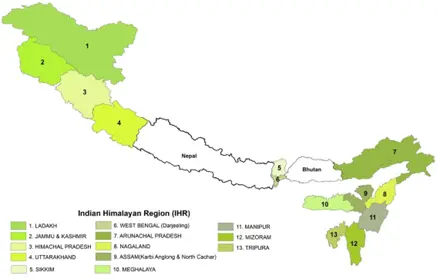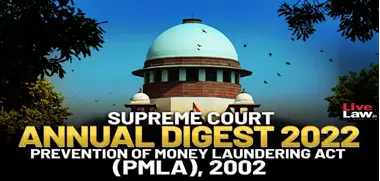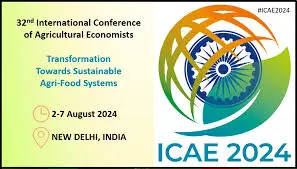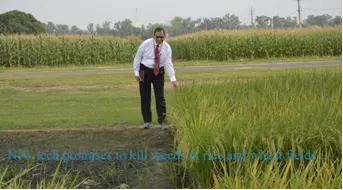Saturday, 10th August 2024
Reducing the Poor’s Health Burden
Why in the news?
- A crucial aspect of household vulnerability is the capacity to manage adverse shocks, such as unexpected medical expenses, which can significantly impact a household's well-being.
- Analysis of unit-level data from the Household Consumption Expenditure Survey (HCES 2022-23) shows a significant reduction in poverty since 2011-12.
- Despite this reduction, it is essential to examine the persistent vulnerabilities among Indian households, especially those in the bottom 50% of the population.
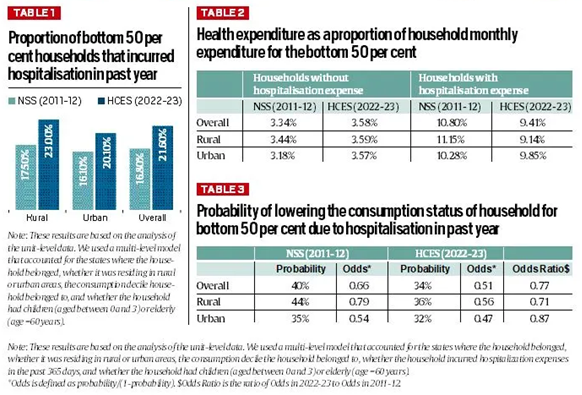
Understanding the Burden of Medical Expenditure:
- A Significant Financial Challenge:
- Medical expenditure poses a substantial financial challenge for many households, particularly those in lower-income brackets.
- Out-of-pocket expenses make up a large portion of healthcare costs in India, leading to long-term financial instability and reduced overall well-being.
- This burden is particularly severe in cases of hospitalisation, where costs are higher and often unexpected.
- The Nature of Medical Shocks:
- Medical shocks, especially those involving hospitalisation, differ from routine healthcare expenses.
- Routine expenses, such as consultations and medications, are predictable and can be managed within a household's monthly budget.
- Hospitalisation, however, often requires a large lump-sum payment, overwhelming households in the bottom 50% of the income distribution.
- These households typically have limited savings and lack access to credit or insurance, making it difficult to absorb the shock without compromising other essential expenditures.
- Medical shocks, especially those involving hospitalisation, differ from routine healthcare expenses.
- Economic Implications of Medical Expenditure:
- The economic effects extend beyond immediate financial strain:
- Difficult trade-offs: Households may need to reduce spending on nutritious food, delay or forgo education expenses, or neglect home maintenance.
- Some households may even resort to selling assets, taking on high-interest loans, or withdrawing children from school to cope with the financial burden.
- The economic effects extend beyond immediate financial strain:
Policy Response:
- Government Initiatives:
- Recognizing the severe burden of medical expenditure, the Indian government has implemented policies to reduce this financial strain.
- Ayushman Bharat Yojana: This program aims to provide financial protection against high medical costs, particularly for lower-income households, by covering a significant portion of hospitalisation expenses.
- These initiatives help alleviate the immediate financial burden and reduce the vulnerability of households to falling into poverty due to health-related shocks.
- Recognizing the severe burden of medical expenditure, the Indian government has implemented policies to reduce this financial strain.
An Analysis of Rising Healthcare Accessibility, Affordability, Vulnerability, and Consumption Status
- Rising Healthcare Accessibility and Affordability:
- The incidence of hospitalisation among the bottom 50% of the population increased from 17% in 2011-12 to 22% in 2022-23.
- This increase reflects improved access to healthcare, particularly in rural areas, where the rate rose from 18% to 23%, compared to an increase from 16% to 20% in urban areas.
- The findings suggest significant improvements in healthcare accessibility for the poorest half of the population across India.
- The incidence of hospitalisation among the bottom 50% of the population increased from 17% in 2011-12 to 22% in 2022-23.
- Ratio of Healthcare Expenditure to Overall Household Expenditure:
- The analysis explores the ratio of health expenditure to overall household expenditure, both with and without hospitalisation.
- For households without hospitalisation, health expenditure as a percentage of monthly spending increased marginally over the decade.
- However, for households experiencing hospitalisation, there was a notable decline in this ratio.
- Among the bottom 50% of households, the ratio decreased from 10.8% to 9.4% over ten years.
- In rural areas, the ratio decreased from 11.15% to 9.14%, while in urban areas, the decline was less significant, from 10.3% to 9.9%.
- These trends indicate that healthcare involving significant hospitalisation costs has become more affordable for the poorest half of the population, especially in rural areas.
- The analysis explores the ratio of health expenditure to overall household expenditure, both with and without hospitalisation.
- Vulnerability and Consumption Status:
- The vulnerability of households, particularly those incurring hospitalisation costs, is evident in the change in consumption status.
- In 2011-12, 40% of the poorest half of the population who experienced hospitalisation saw a decline in their consumption status.
- By 2022-23, this proportion had decreased to 33%, indicating a 23% reduction in the odds of households facing a decline in consumption status due to hospitalisation.
- The reduction is more pronounced in rural areas, where the odds of a decline in consumption status decreased by 29%, compared to a 14% decline in urban areas.
- These trends suggest that the financial burden of hospitalisation is becoming less severe, reducing household vulnerability.
- The vulnerability of households, particularly those incurring hospitalisation costs, is evident in the change in consumption status.
- Significant Decline in Loss of Consumption Due to Medical Expenditure:
- Over the past decade, healthcare has become more accessible and affordable for the bottom 50% of the population.
- The analysis reveals a significant decline in the odds of households experiencing a loss in consumption status due to the financial burden of hospitalisation.
- This reduction is particularly evident in rural areas and among households with young children and elderly members.
- These trends are closely linked to public health policies such as Ayushman Bharat Yojana, which aims to alleviate the financial burden of hospitalisation for the poor.
- Over the past decade, healthcare has become more accessible and affordable for the bottom 50% of the population.
Conclusion
While the decline in poverty is an important achievement, addressing household vulnerability to medical shocks is crucial for ensuring sustainable well-being and economic stability. Improved accessibility and affordability of healthcare, along with the reduction in financial vulnerability due to hospitalisation, are positive steps toward enhancing the overall welfare of the bottom half of India's population
|
UPSC Civil Services Examination, Previous Year Question (PYQ) Prelims: Q:1 Which of the following is/are the indicators/ indicators used by IFPRI to compute the Global Hunger Index Report? (2016)
Select the correct answer using the code given below:
Ans: C
Mains: Q:1 How far do you agree with the view that the focus on lack of availability of food as the main cause of hunger takes the attention away from ineffective human development policies in India? (2018) |
Source: IE
Need to Balance Trial Delays and Bail Rights Under PMLA
Why in the news?
- The Supreme Court recently granted bail to former Delhi Deputy Chief Minister Manish Sisodia.
- The Court emphasised that under such circumstances, the right to bail should be considered a part of Section 45 of the Prevention of Money Laundering Act (PMLA).
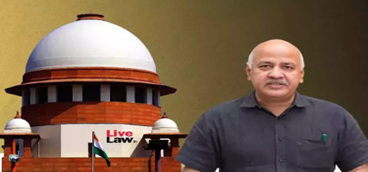
Bail is the Rule, and Jail is the Exception Principle:
- About:
- Origin:
- This principle was first established in the 1977 landmark judgement of the 'State of Rajasthan vs Balchand alias Baliya' case.
- The ruling emphasised that bail should be denied only when there is a risk of the accused fleeing, obstructing justice, repeating offences, or intimidating witnesses.
- This principle has been repeatedly cited in numerous cases, reinforcing its significance in upholding personal liberty.
- Origin:
- SC Invoking This Principle:
- 2G Spectrum Case (2011):
- The Court granted bail to five accused, reaffirming that bail is the rule.
- INX Media Case (2019):
- The Court granted bail to P Chidambaram, despite the seriousness of economic offences, underscoring that the fundamental jurisprudence of bail remains unchanged.
- Arnab Goswami Case (2020):
- The Supreme Court extended interim bail to journalist Arnab Goswami, emphasising the critical nature of personal liberty and the principle of bail as the norm.
- CJI DY Chandrachud’s Address (2024):
- At the All-India District Judges Conference, CJI Chandrachud expressed concerns about the declining adherence to this principle in lower courts.
- Stressing the need for judges to prioritise personal liberty and adhere to established legal standards.
- 2G Spectrum Case (2011):
Section 45 of the PMLA:
- Provisions:
- Section 45 of the PMLA specifies the conditions for granting bail:
- The Public Prosecutor must be given an opportunity to oppose the bail application.
- If opposed, the Court must be satisfied that:
- There are reasonable grounds to believe the accused is not guilty.
- The accused is not likely to commit any offence while on bail.
- Section 45 of the PMLA specifies the conditions for granting bail:
- Implication:
- This section sets a high bar for granting bail, as indicated by its negative language, making bail the exception rather than the rule under the PMLA.
Twin Test of Bail under Section 45 of PMLA
- Stringent Thresholds:
- The accused must prove prima facie innocence.
- The accused must convince the judge that they will not commit any offences while on bail.
- Burden of Proof:
- The burden is entirely on the accused, who may be at a disadvantage against the state’s resources.
- The twin conditions create a significant barrier to obtaining bail under the PMLA.
- Pre-2019 Amendments:
- Prior to the 2019 amendments, the law assumed the accused were guilty of the original crime (the "scheduled offence") and required them to prove otherwise to obtain bail.
Key Highlights of the Judgement:
- Delay in Trial and Prolonged Imprisonment:
- The Supreme Court ruled that delays in trial and prolonged imprisonment are valid grounds for granting bail, even under stringent laws like the PMLA.
- Right to Speedy Trial:
- The Court held that the constitutional mandate for a speedy trial is a higher law than statutory provisions that restrict bail.
- It emphasised that bail cannot be opposed merely on the seriousness of the crime, noting that in matters of liberty, everyday counts.
- Caution to Trial Courts and High Courts:
- The apex court observed that trial courts and High Courts tend to play it safe by denying bail, which can be detrimental to personal liberty.
- This ruling is expected to influence other cases under the PMLA, encouraging accused individuals to seek bail if there are delays in their trial, even if the merits of their case are not in their favour.
|
UPSC Civil Services Examination, Previous Year Questions (PYQs) Mains Q:1 Discuss how emerging technologies and globalisation contribute to money laundering. Elaborate measures to tackle the problem of money laundering both at national and international levels. (2021) |
Source: TOI
RBI Monetary Policy Meeting 2024
Why in the news?
- Recently, in its first meeting post-Union Budget, the Reserve Bank of India’s Monetary Policy Committee (MPC) maintained the policy repo rate at 6.50% for the ninth consecutive time.
- Out of six members, four voted in favour of this decision aimed at controlling inflation.
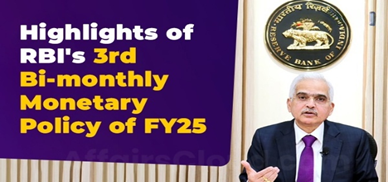
What is the Monetary Policy Committee (MPC) ?
- The Committee:
- Established under Section 45ZB of the amended RBI Act, 1934, the central government has the authority to form a six-member Monetary Policy Committee (MPC).
- The MPC’s primary role is to set the policy interest rate needed to achieve the inflation target. The first MPC was formed in September 2016.
- Members of MPC:
- RBI Governor (ex officio chairperson)
- Deputy Governor in charge of monetary policy
- An officer nominated by the Central Board of the RBI
- Three members appointed by the central government
- Functions of MPC:
- Setting Policy Interest Rates: The MPC's main function is to determine policy interest rates, particularly the repo rate.
- Inflation Targeting: The current inflation target is set at 4% CPI inflation with a tolerance band of +/- 2%.
- Economic Analysis and Forecasting: The MPC analyses and forecasts various economic indicators like inflation, GDP growth, employment, fiscal conditions, and global developments.
- Decision-Making: The MPC meets at least four times a year to review and adjust monetary policy.
What are the key Outcomes of MPC 2024?
- Policy Rates Remain Unchanged:
- The policy repo rate was kept at 6.50%.
- Repo Rate: The rate at which RBI lends money to commercial banks.
- Standing Deposit Facility (SDF): Rate remains at 6.25%; SDF allows banks to park excess liquidity with RBI without needing collateral.
- Marginal Standing Facility (MSF) and Bank Rate: Both remain at 6.75%. MSF is an emergency borrowing window for banks.
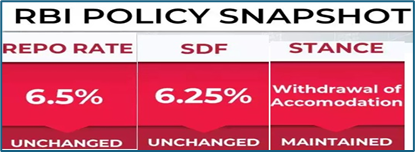
- Monetary Stance:
- MPC continues to focus on withdrawing accommodation to align inflation with the target while supporting growth.
- Withdrawal of Accommodation: Reducing money supply to control inflation.
- Food Prices Drive Inflation:
- Headline inflation rose to 5.1% in June, driven primarily by food inflation.
- Core inflation moderated, and the fuel group remained in deflation.
- The pace of disinflation is slow, with a significant gap remaining to reach the inflation target.
- GDP Forecast:
- Real GDP growth for 2024-25 is projected at 7.2%, with quarterly estimates ranging from 7.1% to 7.3%.
What other Announcements Made During MPC 2024?
- Increase in UPI Transaction Limit for Tax Payments:
- The transaction limit for tax payments via UPI has been increased from ₹1 lakh to ₹5 lakh per transaction.
- This move aims to streamline tax payments and strengthen the tax-collection system.
- Creation of Digital Lending Apps Repository:
- RBI plans to create a public repository of digital lending apps on its website to protect customers from fraudulent players in the financial services sector.
- Focus on Deposit Mobilization:
- RBI Governor expressed concern over the slower deposit growth compared to credit growth, urging banks to offer innovative deposit products to avoid potential liquidity issues.
- Food Inflation Concerns:
- Despite suggestions to exclude food prices from headline inflation, the RBI Governor emphasised that food inflation cannot be ignored due to its significant impact on the public and overall inflation.
- The NSO is conducting a survey to reassess the CPI basket, which may influence future inflation calculations.
|
UPSC Civil Services Examination, Previous Year Questions (PYQs) Prelims Q:1 Which of the following statements is/are correct regarding the Monetary Policy Committee (MPC)? (2017)
Select the correct answer using the code given below:
Ans: (a)
Q:2 If the RBI decides to adopt an expansionist monetary policy, which of the following would it not do? (2020)
Select the correct answer using the code given below:
Ans: (b)
Mains: Q:1 Do you agree with the view that steady GDP growth and low inflation have left the Indian economy in good shape? Give reasons in support of your arguments. (2019) |
Source: HT
Google ‘monopoly’ antitrust case
Why in the News?
- The US District Court of Columbia accused Google of leveraging its dominant position in the online search market by making exclusive deals with smartphone manufacturers like Apple and Samsung.
- The Court ruled that Alphabet Inc.’s (Google's parent company) $26 billion payments to make Google the default search engine on smartphone web browsers violated US antitrust laws.
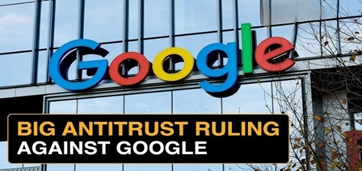
What is the US Antitrust Ruling Against Google?
- Google as a Monopolist: Google was found to have violated antitrust laws to maintain a monopoly over “general search services” and “general search text ads.”
- Default Search Engine Advantage: By being the “default” search engine, Google enjoys an unseen advantage, as most users tend to stick with the default option.
- Global Reach: Google’s search engine processes approximately 8.5 billion queries per day worldwide, nearly doubling its daily volume from 12 years ago.
- Geographic Focus: The judgement is limited to the US market, as market conditions differ globally. For instance, Xiaomi dominates the Indian mobile phone market, where the Opera browser and search function are pre-installed.
Consequences of Google’s Position as the Default General Search Engine (GSE)
- Entry Barriers for New Entrants:
- High capital costs, access to distribution channels, and brand recognition are significant barriers for any new entrant aiming to create a GSE comparable to Google.
- Revenue Challenges:
- New entrants face the challenge of building an ads platform that can monetize search on par with Google, along with potential revenue shortfalls due to reduced query volume or inferior ad monetization.
Steps Taken in India to Address Google’s Monopoly:
- Monetary Penalty:
- In 2022, the Competition Commission of India (CCI) imposed a fine of ₹1,337.76 crores on Google for mandating the pre-installation of Google Mobile Suite (including Google Search, YouTube, and Gmail) on Android devices without an option to uninstall these apps.
- Following this verdict, Google allowed Indian users to choose their default search engine.
- Draft Competition Bill 2024:
- The Ministry of Corporate Affairs introduced a bill aimed at preventing giant tech companies, or Systemically Significant Digital Enterprises (SSDEs), from engaging in anti-competitive practices.
- The bill restricts SSDEs from favouring their own products and services and from using or sharing users’ personal data without consent.
- However, big tech companies have objected, arguing that the bill’s compliance burdens could detract from innovation and research.
- Recent Complaints:
- The Alliance of Digital India Foundation (ADIF) filed a complaint against Google, accusing it of anti-competitive practices in the online advertising market.
Implications of the US Antitrust Ruling Against Google
- Precedent for Big Tech Firms:
- Nearly a quarter-century after a similar antitrust ruling against Microsoft, this landmark judgement could set a new precedent for how Big Tech firms conduct business.
- Potential Structural Changes:
- The ruling could fundamentally alter the structure of digital businesses, particularly those linked to Google’s range of digital services.
- Impact on Revenue Streams:
- If Google is ordered to terminate its exclusive deals with companies like Apple, it could immediately wipe out a significant revenue stream for handset makers.
- Incentives for Rivals:
- Companies like Apple and Samsung might be incentivized to develop their own search engines, offering consumers alternatives to pre-loaded options on their smartphones.
- Effectiveness of Alternatives:
- The effectiveness of alternative search engines will need to be assessed over time to determine their competitiveness with Google.
- Focus on User Privacy:
- This ruling might push Google to develop better products with a stronger focus on user privacy.
- Wider Impact on Big Tech:
- The ruling will likely influence ongoing antitrust cases against other Big Tech firms such as Meta, Amazon, and Apple, scrutinising their monopolistic practices.
Conclusion
This structured breakdown provides a comprehensive overview of the US antitrust ruling against Google, its implications, and parallels drawn from the Indian regulatory environment.
Source: TH
Office of Vice President of India
Why in the news?
- Recent developments have seen 50 Opposition MPs sign a resolution to bring a no-confidence motion against Vice-President Jagdeep Dhankhar.
- Under Article 67(B) of the Indian Constitution, the Vice President can be removed by a resolution passed by a majority in the Rajya Sabha and agreed upon by the Lok Sabha with a simple majority.
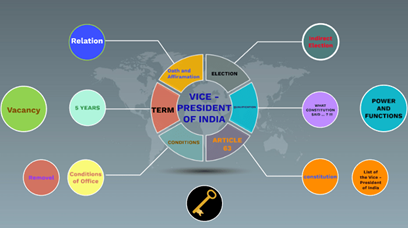
About the Vice President of India:
- Position:
- The Vice President of India is the second-highest constitutional office in the country, following the President of India.
- Established under Article 63 of the Constitution, the office is pivotal in the legislative and executive branches of the Indian government.
Key Responsibilities:
- Chairman of the Rajya Sabha:
- The primary role of the Vice President is to serve as the ex-officio Chairman of the Rajya Sabha (Council of States), the upper house of Parliament.
- As Chairman, the Vice President presides over Rajya Sabha sessions, ensuring that debates and discussions adhere to procedural rules.
- Acting President:
- In the event of a vacancy in the office of the President or if the President is incapacitated, the Vice President serves as Acting President until a new President is elected or the President resumes duties.
- Succession:
- The Vice President is next in line to succeed the President in case of death, resignation, or removal.
- The Vice President does not automatically assume the role of President; instead, this position is temporary until a new election is conducted.
Election Process
- Electoral College:
- The Vice President is elected by an electoral college consisting of members from both houses of Parliament (Lok Sabha and Rajya Sabha).
- Voting System:
- The election is conducted through a system of proportional representation by means of a single transferable vote.
- Conduct:
- The Election Commission of India oversees the election process.
Qualifications
- Eligibility Criteria:
- The candidate must be a citizen of India.
- The candidate must be at least 35 years of age.
- The candidate must be qualified to be elected as a member of the Rajya Sabha.
Term of Office & Removal:
- Term:
- The Vice President serves a five-year term and is eligible for re-election.
- Resignation:
- The Vice President may resign by submitting a resignation letter to the President.
- Removal:
- Under Article 67(B) of the Constitution, the Vice President can be removed by a resolution passed by a majority in the Rajya Sabha and agreed upon by the Lok Sabha with a simple majority.
- The resolution requires “at least fourteen days’ notice” before being moved.
|
UPSC Civil Services Examination, Previous Year Questions (PYQs) Prelims
Which of the statements given above is/are correct?
Answer: B |
Source: TH
Gout
Why in the news?
- On August 9, 2024, the CSIR-National Botanical Research Institute (CSIR-NBRI) in Lucknow introduced a herbal product named ‘NBRI-Gout Out.’
- This product is formulated from a combination of five medicinal plants to combat Gout.
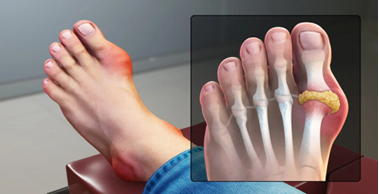
What is Gout?
- About:
- Nature of the Condition: Gout is a prevalent and intricate form of arthritis that can impact anyone.
- Cause:
- Underlying Factor: The condition arises due to elevated levels of uric acid in the blood serum.
- Gender Prevalence: Gout is more commonly observed in men, largely because women generally have lower levels of uric acid.
- Risk Factors: Various factors can increase uric acid levels, potentially leading to Gout, including:
- Obesity: Excessive body weight is a significant contributor.
- Medications: Certain drugs, such as diuretics (water pills), can elevate uric acid levels.
- Diet: Foods and beverages high in purines—such as alcohol and sugary drinks—can also trigger Gout.
- Symptoms:
- Joint Pain: Gout typically causes severe pain in the big toe but can affect any joint. Commonly affected joints include the ankles, knees, elbows, wrists, and fingers.
- Inflammation and Redness: The affected joints often become swollen, tender, warm, and red.
- Treatment:
- Medication: Drugs like allopurinol (Aloprim, Lopurin, Zyloprim) and febuxostat (Uloric) are used to limit the body's production of uric acid
About: PIB
Triboelectric Nanogenerator (TENG) Technology
Why in the news?
- On August 9, 2024, the Indian Institute of Technology (IIT) Indore developed special shoes for soldiers, incorporating Triboelectric Nanogenerator (TENG) Technology.
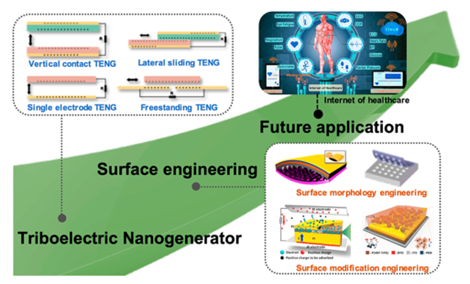
What is the Triboelectric Nanogenerator (TENG) Technology?
- About:
- Functionality: TENG technology provides a self-powered, feasible solution for converting mechanical energy into electricity.
- Electricity Storage: The generated electricity is stored in a device embedded in the soles, which can be used to power small appliances.
- Features:
- Advanced Technologies: The shoes are equipped with Global Positioning System (GPS) and Radio Frequency Identification (RFID) technologies, enabling real-time location tracking of personnel.
- Applications:
- Location Tracking: TENG technology can be applied to track senior citizens with Alzheimer's, school children, climbers, and factory workers, helping monitor their attendance and work.
- Sports Performance: These shoes can precisely analyse the movements of sportspersons, aiding in performance enhancement.
- Trekking and Mountaineering: The self-powered GPS feature in the shoes offers reliable tracking during expeditions, ensuring safety and efficient navigation for trekking and mountaineering enthusiasts.
Source: HT
Cheque Truncation System (CTS)
Why in the news?
- On August 9, 2024, the Reserve Bank of India (RBI) announced a measure for the Continuous Clearing of Cheques under the Cheque Truncation System (CTS) to expedite cheque clearance.
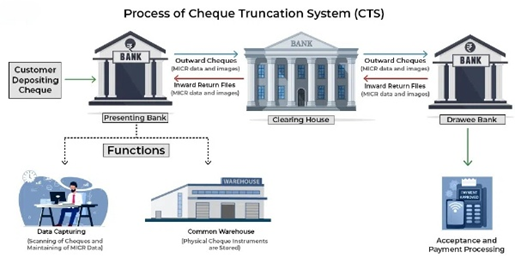
What is the Cheque Truncation System (CTS)?
- About:
- Cheque Truncation: Truncation refers to stopping the physical movement of a cheque issued by the drawer at the presenting bank, before it reaches the paying bank branch.
- CTS Definition:
- CTS is an online, image-based cheque-clearing system.
- It captures cheque images and Magnetic Ink Character Recognition (MICR) data at the collecting bank branch and transmits them electronically, eliminating the need for physical cheque movement.
- Security:
- Security Architecture: CTS is secured with a Public Key Infrastructure (PKI)-based security system, including dual access control, user IDs, passwords, and crypto box and smart card interfaces.
- CTS-2010 Standards:
- Only cheques compliant with CTS-2010 standards can be processed through CTS.
- These standards ensure cheque standardisation nationwide, incorporating mandatory security features like high-quality paper, watermarks, invisible ink bank logos, void pantographs, and standardised field placements.
- Benefits:
- Same-Day Realisation: Enables the realisation of cheque proceeds on the same day.
- Data Management: Facilitates easy storage and retrieval of cheque data.
- Risk Minimization: Introduces a secure cheque-clearing system, reducing risks.
- Cost Efficiency: Reduces costs associated with the physical movement of cheques.
- Faster Processing: Minimises delays between cheque presentation and realisation.
- Shorter Clearing Cycles: Offers shorter clearing cycles with a centralised image archival system.
- Upcoming Enhancements:
- Continuous Clearing of Cheques: Following RBI’s new measures, CTS will soon clear cheques within hours of submission, compared to the current two-day clearing cycle
Source: TH
Monkeypox (Mpox)
Why in the news?
- Recently, the World Health Organisation (WHO) called an emergency meeting to discuss the outbreak of Monkeypox (Mpox) amid the recent surge in cases from Congo.
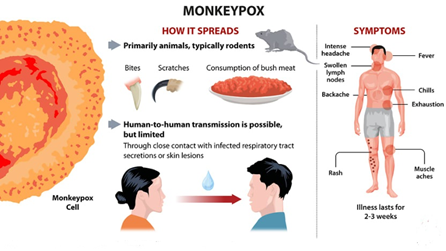
What is Monkeypox?
- About:
- Viral Zoonotic Disease: Monkeypox is a viral zoonotic disease, meaning it transmits from animals to humans. It is named after its pox-like symptoms in monkeys and is endemic to Nigeria.
- Causative Agent: The disease is caused by the monkeypox virus, part of the Orthopoxvirus genus within the Poxviridae family.
- Natural Host: The exact natural host of the virus remains unidentified. However, it has been observed in various animals, including monkeys, apes, rodents (like rats, mice, squirrels, prairie dogs), and rabbits.
- Outbreaks:
- First Report: Monkeypox was first reported in 1958 among monkeys in the Democratic Republic of Congo (DRC) and later in humans in 1970, also in the DRC.
- Significant Outbreaks:
- In 2017, Nigeria experienced the largest documented outbreak after 40 years of no confirmed cases.
- The disease has since been reported in multiple West and Central African countries.
- Symptoms:
- Rash: Infected individuals develop a rash resembling chickenpox. However, the fever, malaise, and headache associated with monkeypox are typically more severe than in chickenpox.
- Lymph Gland Enlargement: In the early stages, monkeypox can be distinguished from smallpox by the enlargement of lymph glands.
- Transmission:
- Animal-to-Human:
- Primary infection occurs through direct contact with the blood, bodily fluids, or lesions of an infected animal.
- Consuming undercooked meat from infected animals also poses a risk.
- Human-to-Human:
- Transmission between humans can occur through close contact with respiratory secretions, skin lesions, or contaminated objects.
- Transmission can also happen through inoculation or via the placenta, leading to congenital monkeypox.
- Animal-to-Human:
- Vulnerability:
- Rapid Spread and Mortality: Monkeypox spreads rapidly and can lead to death in about one out of ten infected individuals.
- Treatment and Vaccine:
- No Specific Treatment:
- Currently, there is no specific treatment or vaccine for monkeypox.
- The smallpox vaccine, which was 85% effective in preventing monkeypox, is no longer widely available since the global eradication of smallpox in 1980.
- Lack of Global Management: There is no global system in place to manage the spread of monkeypox, leaving countries to handle outbreaks individually.
- No Specific Treatment:
|
UPSC Civil Services Examination, Previous Year Questions (PYQs) Prelims: Q:1 The term ‘ACE2’ is talked about in the context of (2021)
Ans: (d)
Q:2 Which of the following are the reasons for the occurrence of multi-drug resistance in microbial pathogens in India? (2019)
Select the correct answer using the code given below.
Ans: (b)
Mains: Q:1 Critically examine the role of WHO in providing global health security during the Covid-19 pandemic. (2020) |
Source: TH
India's Path to a $30 Trillion Economy by 2047
Context:
- India’s economic growth is often celebrated prematurely, despite its 7%-plus GDP growth rate and position as the fastest-growing large economy.
- To realise its goal of a $30-trillion economy by 2047, India must sustain rapid growth through liberal economic policies and leverage the private sector's potential.
- As India approaches its centenary of independence in 2047, transitioning from a developing to a developed economy presents both a challenge and an opportunity.
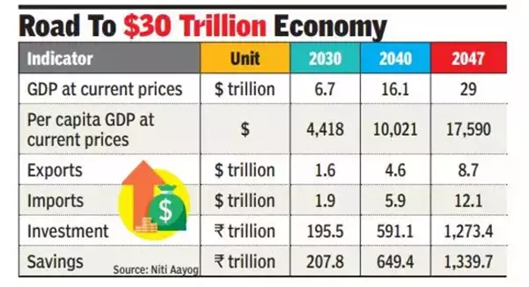
What are the challenges in Achieving Developed Economy Status by 2047 ?
- Poverty and Inequality:
- Despite implementing socialist policies aimed at poverty alleviation, India's poverty rate remained around 50% from Independence until 1991. Post-liberalization (1991-2011) saw a significant reduction, with poverty dropping to about 20% and lifting 350 million people out of poverty.
- Middle-Income Trap:
- The World Bank defines the middle-income trap as a situation where a country fails to transition from middle-income to high-income status due to rising costs and declining competitiveness.
- India risks falling into this trap, as only 23 of 101 middle-income economies in 1960 reached high-income status by 2018.
- There are concerns that India may struggle to advance beyond a per capita income of USD 5,000-6,000.
- Ageing Population:
- India's population, currently approximately 1.4 billion, is projected to peak at 1.64 billion by 2048 before declining to 1.45 billion by 2100.
- This demographic shift will pose challenges related to increasing healthcare costs, growing pension obligations, and potential labour shortages.
- Stagnated Agriculture:
- Agriculture employs around 46% of India's population but contributes only 16.5% to GDP.
- The sector's stagnation is attributed to ineffective land reforms, unscientific practices, insufficient institutional credit, and climate variability.
- Lacking Manufacturing Sector:
- The manufacturing sector employs only 11.4% of India's workforce, facing issues such as high input costs and fluctuating demand, according to the Economic Survey 2023-24.
- Poor Logistics:
- Logistics costs in India, ranging from 14-18% of GDP, exceed the global benchmark of 8%.
- India ranks 38th in the Logistics Performance Index (LPI) 2023, reflecting inefficiencies in the sector.
- Joblessness and Disguised Unemployment:
- Despite high growth years driven by the IT services boom (2000-10), 46% of the labour force remains in agriculture, contributing only 18% to GDP.
- Additionally, the unemployment rate surged to 9.2% in June 2024 from 7% in May 2024, according to CMIE.
- Labor Force Dynamics:
- Female labour force participation is at 37%, although improved from 26% in 2019.
- This rate remains low compared to other rapidly growing nations.
- Global Economic Slowdown:
- The global economic slowdown, along with volatile commodity prices, geopolitical tensions, and tightening financial conditions, hampers India's economic development.
- These factors affect exports, increase import costs, and complicate recruitment and financing for development projects.
Key Measures Taken by the Government:
- Increase in CAPEX:
- In FY24, capital expenditure was increased by 28.2% year-on-year, with a focus on infrastructure development and encouraging private sector participation.
- Credit Growth:
- Scheduled Commercial Banks disbursed Rs 164.3 lakh crore in credit, reflecting a 20.2% growth. The Gross Non-Performing Assets (GNPA) ratio improved to 2.8%, reaching a 12-year low.
- Infrastructure Development:
- The construction pace of National Highways increased from 11.7 km per day in FY14 to 34 km per day by FY24. The Gati Shakti scheme (National Master Plan for multi-modal connectivity) aims to enhance coordination in infrastructure planning and execution to reduce logistics costs.
- National Monetisation Pipeline (NMP):
- The NMP projects a monetisation potential of Rs 6 lakh crore through the leasing of core assets in sectors such as roads, railways, power, oil and gas pipelines, telecom, and civil aviation over a four-year period (FY 2022-25).
- Digital India Initiative:
- The initiative focuses on national empowerment by improving living standards and promoting transparency through the development of digital infrastructure.
- National Education Policy and Skill India Mission:
- These initiatives aim to provide quality education and enhance skills across the population.
- Providing Direct Benefits:
- Programs like Direct Benefit Transfer (DBT) and Jan Dhan Yojana have improved fiscal efficiency and reduced leakages, thereby enhancing the expenditure capacity of individuals.
- Promoting Sustainability and Climate Resilience:
- India is pursuing sustainable economic development through Panchamrit targets and schemes such as the Solar Mission and National Wind-Solar Hybrid Policy.
Way Forward for India’s Economic Development:
- Developing Industrial Clusters:
- Enhance infrastructure by establishing industrial clusters with robust support systems.
- Implement a cluster-led model with relaxed regulations in designated areas to foster manufacturing.
- Avoid high tariffs that may hinder local manufacturers and reduce export competitiveness.
- Maintain Growth Momentum:
- Sustain the impressive GDP growth of 8.2% achieved in FY24, aiming to consistently surpass 8% in future quarters.
- Ensure that this strong growth trajectory continues to support the goal of achieving developed economy status.
- Addressing the Middle-Income Trap and Ensuring Growth:
- Develop a market-led economy that supports private enterprise with minimal government intervention.
- Focus on improving the 'ease of doing business' and advancing economic reforms.
- Adopt the '3i' strategy (investment, infusion, innovation) as outlined in the World Bank’s World Development Report 2024 to navigate the middle-income trap, emulating successful models like South Korea.
- Expand Infrastructure:
- Invest in transport, urban development, and digital infrastructure, continuing the positive trends in National Highways construction and new airport terminals.
- Enhance rural and urban connectivity through initiatives such as the Pradhan Mantri Gram Sadak Yojana.
- Advancing Financial Sector and Monetary Stability:
- Improve banking sector health and financial intermediation, supported by the Insolvency and Bankruptcy Code.
- Focus on Skill Development and Employment:
- Invest in education and vocational training to bridge skill gaps, improve employment outcomes, and increase workforce participation.
- Increase female labour force participation, with potential economic benefits estimated by the IMF to boost GDP by 27% if aligned with male participation rates.
- Unleashing Demographic Dividend:
- Create low-skilled, employment-intensive manufacturing jobs to harness the potential of India's working-age population, drawing inspiration from strategies used by 'Asian Tigers' like South Korea and Vietnam.
- Diversify and Expand:
- Support growth in key industries such as pharmaceuticals and electronics.
- Leverage India's strengths in the services sector to expand its global market share.
- Foster Innovation:
- Encourage the development of start-ups and the gig economy to drive new business models and technological advancements.
- Green Transition:
- Accelerate investments in clean energy and sustainable practices.
- Expand renewable energy sources to meet projected increases in energy needs.
Conclusion
To achieve developed country status by 2047, India must pursue holistic development beyond mere economic growth. This requires addressing economic, social, environmental, and institutional factors. A comprehensive approach that integrates these dimensions will ensure balanced and sustainable progress, ultimately enhancing the overall well-being of its citizens.
|
UPSC Civil Services Examination, Previous Year Questions (PYQs) Prelims: Q:1 Increase in absolute and per capita real GNP do not connote a higher level of economic development, if (2018)
Ans: (c)
Mains:
Q:1 Justify the need for FDI for the development of the Indian economy. Why is there a gap between MoUs signed and actual FDIs? Suggest remedial steps to be taken for increasing actual FDIs in India. (2016) |
Source: TH
Practice Questions - Current Affairs 10-08-2024
Q1. Propiconazole, Emamectin, and Quinalphos are related to:
(a) pesticides for crop protection in Tea plantations
(b) preservatives in processed foods
(c) fruit-ripening agents
(d) moisturising agents in cosmetics
Q2. Consider the following:
- Hydraulic brake fluids
- cosmetics
- Lubricants
How many of the statements given above are are the application of “Diethylene glycol (DEG)” ?
(a) Only one
(b) Only two
(c) All three
(d) None
Q3. Consider the following statements:
- Helmand is Afghanistan's longest river.
- It originates near Kabul in the western Hindu Kush mountain range.
- Helmand river flows through Pakistan and Afghanistan.
How many of the statements given above are correct?
(a) Only one
(b) Only two
(c) All three
(d) None
Q4. Lake Hamun is located in:
- Iraq
- Iran
- Syria
- Turkey
Q5. Which of the following country in Balkan region was recently mentioned in the news due to ethnic conflicts?
- Serbia
- Albania
- Greece
- Romania
Q6. How many of the following countries does not share its border with Uzbekistan?
- Iran
- Tajikistan
- Kazakhstan
- Kyrgyzstan
Select the correct answer using the code given below:
(a) Only one
(b) Only two
(c) Only three
(d) All four
Q7. Byte-pair Encoding is related to:
- Language model
- Quantum computing
- Malware
- Blockchain technology
Q 8. Arak, Forko and Isfahan regions were recently mentioned in the news, these are located in:
- Turkey
- Iran
- Sudan
- Israel
Q9. Which of the following countries share their border with Lake Albert?
- Democratic Republic of Congo.
- Uganda
- South Sudan
Select the correct answer using the code given below:
- 1 and 2 only
- 2 and 3 only
- 1 and 3 only
- 1, 2 and 3
Q10. Blue Shield" emblem of the 1954 Hague Convention is associated with:
- Access to humanitarian corridors is determined by the parties to the conflict.
- Temporary cessation of fighting to protect civilians.
- Protection and support to refugees in the Event of Armed Conflict.
- Protection of Cultural Property in the Event of Armed Conflict.
Q11. Consider the following Pairs:
Port Country
- Changi Singapore
- Duqm Yemen
- Sabang Indonesia
- Kyaukpyu Myanmar
How many of the Pairs given above is/are correct?
(a) Only one
(b) Only two
(c) Only three
(d) All four
Q12. Consider the following pairs:
Sea Bordering country
- Baltic Sea : Lithuania
- Persian Gulf : Kuwait
- Gulf of Aden : Yemen
- Yellow Sea : South Korea
- Aral Sea : Uzbekistan
How many of the pairs given above are correctly matched?
- Only two
- Only three
- Only four
- All five
Q13. Consider the following Pairs:
Glacier River
- Pindari : Manas River
- Satopanth : Alaknanda River
- Bandarpunch : Yamuna
- Siachen : Nubra
- Gangotri Glacier : Ganges
How many of the pairs given above are correctly matched?
- Only two
- Only three
- Only four
- All five
Q14. With reference to Voice over Wi-Fi (VoWiFi) in communication technologies, consider the following statements:
- Voice over Wi-Fi (VoWiFi) uses high-speed Internet connection, available via broadband, to make and receive high definition (HD) voice calls.
- Keeping VoLTE switched on is essential in VoWiFi for seamless voice calling.
Which of the statements given above is/are correct?
- 1 only
- 2 only
- Both 1 and 2
- Neither 1 nor 2
Q15. Consider the following statements:
- Malaria is predominantly found in the subtropical region of Asia and Africa.
- Malaria parasites spread through the bites of infected female Anopheles mosquitoes.
- Plasmodium falciparum and Plasmodium Vivax are the most common types that infect humans.
- Plasmodium falciparum causes a more severe form of the disease leading to a higher risk of death.
How many of the statements given above is/are correct?
- Only one
- Only two
- Only three
- All four
Share the article
Edukemy’s Current Affairs Quiz is published with multiple choice questions for UPSC exams
MCQ
Get Latest Updates on Offers, Event dates, and free Mentorship sessions.

Get in touch with our Expert Academic Counsellors 👋
FAQs
UPSC Daily Current Affairs focuses on learning current events on a daily basis. An aspirant needs to study regular and updated information about current events, news, and relevant topics that are important for UPSC aspirants. It covers national and international affairs, government policies, socio-economic issues, science and technology advancements, and more.
UPSC Daily Current Affairs provides aspirants with a concise and comprehensive overview of the latest happenings and developments across various fields. It helps aspirants stay updated with current affairs and provides them with valuable insights and analysis, which are essential for answering questions in the UPSC examinations. It enhances their knowledge, analytical skills, and ability to connect current affairs with the UPSC syllabus.
UPSC Daily Current Affairs covers a wide range of topics, including politics, economics, science and technology, environment, social issues, governance, international relations, and more. It offers news summaries, in-depth analyses, editorials, opinion pieces, and relevant study materials. It also provides practice questions and quizzes to help aspirants test their understanding of current affairs.
Edukemy's UPSC Daily Current Affairs can be accessed through:
- UPSC Daily Current Affairs can be accessed through Current Affairs tab at the top of the Main Page of Edukemy.
- Edukemy Mobile app: The Daily Current Affairs can also be access through Edukemy Mobile App.
- Social media: Follow Edukemy’s official social media accounts or pages that provide UPSC Daily Current Affairs updates, including Facebook, Twitter, or Telegram channels.

